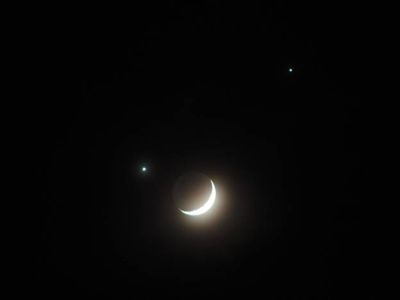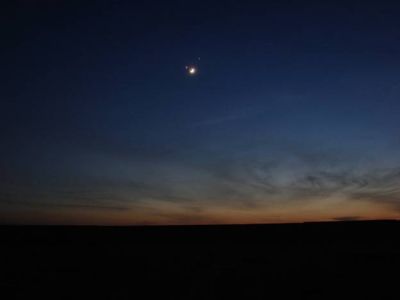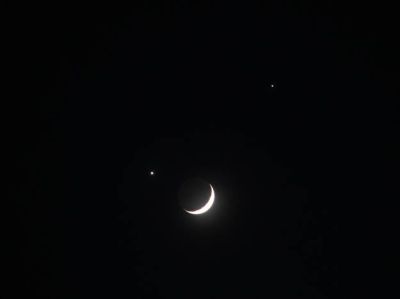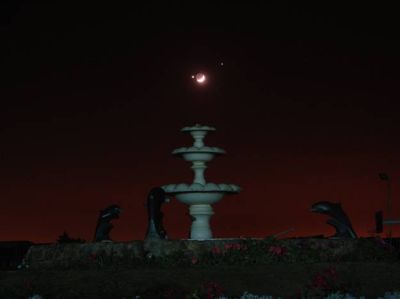02 December 2008

The Moon-Venus-Jupiter Conjunction of 1 December 2008
Venus is the brighter and nearer object to the Moon. Jupiter is visible to the upper right as a bright star-like object. The picture also shows a beautiful optical atmospheric effect, known as the corona. Due to the presence of thin clouds, the crescent and Venus are surrounded by colorful halos of light, or coronae. 12% of the lunar disk was illuminated. Venus was about 5 times brighter than Jupiter.
Photo by Aymen Ibrahem, BA, Senior Astronomy Specialist
On 1 December 2008, the western evening sky featured a spectacular cosmic alignment: two planets were shining brightly, very near to the Crescent Moon, a phenomenon known as conjunction. The planets were Venus, Earth’s “Twin Planet”, and Jupiter, the largest planet. The conjunction was easily visible to the unaided eye, from almost the entire world.
Observing during a PSC star party, near Alexandria, Egypt, BA Senior Astronomy Specialist Aymen Ibrahem took numerous images of the eye-catching spectacle.
When two or more Solar System objects are located near to the line of sight, they are said to be in conjunction. Venus is the brightest planet and the brightest celestial object after the Sun and the Moon. During the conjunction, Venus was less than one degree from the Moon, and separated by only about two degrees from Jupiter, the fourth brightest celestial object.
Sometimes, Mars, the Red Planet, is slightly brighter than Jupiter. Only on rare occasions, a star may explode, and outshine Venus in brightness. Also, a comet may rarely surpass Venus in brightness.
The Moon, our faithful companion, was approximately 403,000 km from Earth. Its distance from Earth varies from about 365,000 km to 407,000 km. With a diameter of 3,476 km, the Moon is approximately ¼ the size of Earth (12,756 km across). The Earth is 81 times more massive than the Moon.
Venus, the nearest planet to Earth, was approximately 400 times more distant than the Moon. Its distance from Earth was slightly larger than the average Earth-Sun distance of approximately 150 million km. Venus is approaching Earth, and will be nearest to our planet in late March 2009.
Jupiter was approximately 870 million km from Earth. It is currently receding. It will reach its maximum distance from Earth in late January 2009, when it will be about 950 million km away.
Venus is similar to Earth in size and Mass, therefore it is known as Earth’s Twin Planet. Mighty Jupiter is far larger than Venus. Its diameter is over 11 times that of Venus, and its mass is approximately 400 times that of Venus. The mass of Venus is approximately 5 × 1024 kg.
Interestingly, due to its orbital motion around Earth, the Moon passed in front of Venus for some parts of the world. This rare intriguing event is termed occultation, and is similar to the solar eclipse. The occultation was visible from most of Europe and Northwest Africa. The picture gallery below presents some of Ibrahem’s images of the memorable conjunction.
Picture Gallery

An Evening Planetary Parade
The Moon became visible prior to sunset. Venus and Jupiter were observable to the unaided eye, shortly after sunset.
Photo by Aymen Ibrahem, BA, Senior Astronomy Specialist

Cosmic Jewels
The picture shows the three evening luminaries: the Crescent Moon, Venus and Jupiter. The Moon orbits Earth at a speed of approximately 3,500 km/h. It actually crept toward Venus, and blocked it from view in a few Arab countries: Tunisia, Algeria, Morocco and Mauritania.

Planets and Leaping Dolphins
The picture shows the celestial wonder over a beautiful fountain that was located in the star party area.
Photo by Aymen Ibrahem, BA, Senior Astronomy Specialist
Further Reading
A Mesmerizing Twilight over the BA
../home/NewsDetail.aspx?Find=%2fhOax1BBFsp7XXTfRDpWKg%3d%3d
The Moon
http://www.nineplanets.org/luna.html
Venus
http://www.nineplanets.org/venus.html
Jupiter
http://www.nineplanets.org/jupiter.html
Aymen Mohamed Ibrahem
Senior Astronomy Specialist